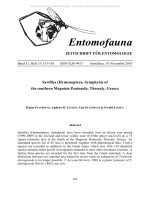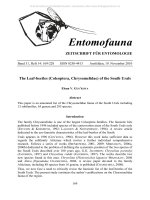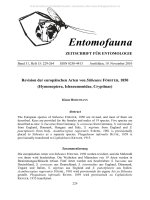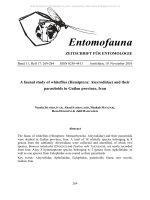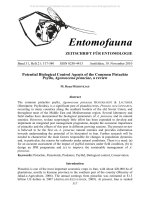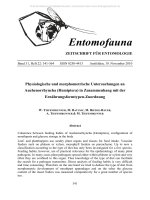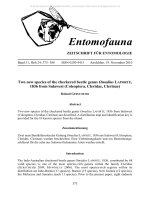Entomofauna, ZEITSCHRIFT FÜR ENTOMOLOGIE VOL 0031-0153-0168
Bạn đang xem bản rút gọn của tài liệu. Xem và tải ngay bản đầy đủ của tài liệu tại đây (7.31 MB, 16 trang )
© Entomofauna Ansfelden/Austria; download unter www.biologiezentrum.at
Entomofauna
ZEITSCHRIFT FÜR ENTOMOLOGIE
Band 31, Heft 13: 153-168
ISSN 0250-4413
Ansfelden, 19. November 2010
Sawflies (Hymenoptera, Symphyta) of
the southern Magnisía Peninsula, Thessaly, Greece
Klaus STANDFUSS, Andrew D. LISTON, Lisa STANDFUSS & Ewald JANSEN
Abstract
Sawflies (Hymenoptera, Symphyta) have been recorded over an eleven year period
(1999-2009) in the lowland and lower colline zone (0-350m above sea-level) on a 75
square kilometre area in the South of the Magnisia Peninsula, Thessaly, Greece. An
annotated species list of 85 taxa is presented, together with phenological data. Twelve
species are recorded as additions to the Greek fauna, which now with 210 identified
species remains rather poorly investigated compared to most other European countries. A
further three species are recorded for the first time from the Greek mainland. A clear
distinction between two nominal taxa treated in recent works as subspecies of Tenthredo
distinguenda is no longer possible: T. hyrcana BENSON, 1968 is a junior synonym of T.
distinguenda (STEIN, 1885), syn. nov.
153
© Entomofauna Ansfelden/Austria; download unter www.biologiezentrum.at
Zusammenfassung
Während elf Jahren (1999-2009) wurden in der planaren und der unteren collinen Stufe
(0-350m ü. NN) auf einer Fläche von 75 Quadratkilometern der südlichen MagnisíaHalbinsel, Thessalien, Griechenland, Pflanzenwespen (Hymenoptera, Symphyta) gesammelt. Eine kommentierte Liste von 85 Arten wird zusammen mit deren phänologischen Daten vorgestellt. Zwölf Arten werden erstmals für die Fauna Griechenlands gemeldet. Mit aktuell 210 festgestellten Spezies bleibt die griechische Fauna im Vergleich
zu anderen europäischen Ländern relativ schlecht erforscht. Weitere drei Arten werden
erstmalig vom griechischen Festland nachgewiesen.
Die klare Trennung zweier nomineller Taxa, die in neueren Arbeiten als Unterarten von
Tenthredo distinguenda aufgefasst wurden, ist nicht mehr möglich: T. hyrcana BENSON,
1968 ist ein jüngeres Synonym von T. distinguenda (STEIN, 1885), syn.nov.
Introduction
Knowledge of the taxonomy, biology and distribution of Mediterranean sawflies fauna is
very incomplete. Generally, every updated treatment of a particular region results in a
large number of new faunistic records or newly described species (e.g., SMITH 1983,
BLANK 1993, 2002a, PESARINI 2002, LISTON & SPÄTH 2005, BLANK & TAEGER 2006). A
principal reason is the scarcity of local researchers who are in a position to take up during any season the time-consuming fieldwork. A further hindrance has been the poor
timing of visits by foreign entomologists. In a summer-dry region such as the Mediterranean, vegetational growth peaks during the cool and humid season. This comparatively
short period is of critical importance to a majority of sawfly species in the eumediterranean vegetational zone at lower altitudes. Visiting foreign specialists generally first
arrive when conditions have become warm and dry, and the fresh young growth of hostplants suitable for oviposition is no longer available. Additionally, disproportionate
attention has been paid to the rather species poor Mediterranean islands, with relative
neglect of the much more diverse sawfly fauna of the mainland. Since the first checklist
by HELLÉN (1967), there have been only few published contributions on the Greek fauna:
e.g., by BLANK (1993), LISTON (1983, 1985), PESARINI (2002, 2006) and SCHEDL (1981).
Noteworthy is the discussion by BLANK (1993) of the high species diversity in the
mountains of northern Greece, compared to eumediterranean areas.
The present work reports the results of an attempt to record a local fauna in the eumediterranean zone, based on fieldwork carried out nearly throughout the year on the
southern Magnisia Peninsula, Thessaly, from 1999 to 2009.
154
© Entomofauna Ansfelden/Austria; download unter www.biologiezentrum.at
Material and Methods
Study Area
The area investigated measures approximately 10 x 7.5 km and lies in the planar-colline
zone around 39°8’N/23°16’E. For various reasons, only about 2 km2 of this area is accessible.
Geology is characterised by metamorphic rocks of diverse ages. Calcitic and sericitic
phyllites alternate within very short distances with serpentinite, marble, green slate and
chalk breccia. Alluvial sediments are found only occasionally on parts of the inaccessible
coast.
Climate is eumediterranean, characteristic of the lowest vegetation zone, with the yearly
average temperature being nearly 17 °C according to our own measurements. Frosts in
January and February are rare and short, the summer drought can last five months. Winter precipitation often exceeds 600 mm.
More than 700 fern and flowering plant species are native to the area, of which 50 flower
during the winter months (K. & L. Standfuss, unpublished data). Without man’s influence, the region would be covered with an evergreen forest, dominated by broadleaved
tree species. The actual vegetation is a rapidly changing mixture of successional vegetation arising after regularly occurring fires, mechanical and chemical treatment of agricultural areas, and overgrazing by goats and sheep. Settlement by man and an associated
increase in the use of the very scarce summer rainfall have recently led to the drying out
of the species-rich Mediterranean permanently damp areas. Despite all this, the area can
still be described as insect-rich. The number of species of only the aculeate Hymenoptera
(Apidae, Vespidae, Sphecidae, Pompilidae, Scoliidae, Chrysididae and Mutillidae) is
estimated at about 1000 (L. & K. Standfuss, incompletely published data).
Sampling
The area was sampled between 1999 and 2009 on more than 500 days by K. & L. Standfuss. Specimens were collected exclusively with entomological nets. Voucher specimens
were killed with ethyl acetate, and as a rule pinned and prepared under a stereomicroscope within 24 hours. The majority of specimens was collected by Klaus and Lisa
Standfuss. Vouchers are in the collections of Standfuss (Dortmund, Germany), F.
Pesarini (Ferrara, Italy) and the Senckenberg Deutsches Entomologisches Institut
(Müncheberg, Germany). Labels of these specimens bear the locality information
"Platania, Volos". Data are also included for a few additional species collected in the
same area by S. M. Blank, H.-J. Jacobs, E. Jansen, A. Liston, H. Schnee and A. Taeger
during the 11th International Sawfly Workshop at Platania, 05.-08.05.2007. Nomenclature follows TAEGER et al. (2006) except where otherwise mentioned.
155
© Entomofauna Ansfelden/Austria; download unter www.biologiezentrum.at
Data presentation
The list presents the observed phenology for all species in monthly intervals (3 to 10 for
March to October), offering an insight on this neglected aspect of sawfly biology in the
eumediterranean zone. Species recorded only in the larval stage are denoted with an L
before the month in which these were recorded. Families and subfamilies are listed in
alphabetical order, with the species in alphabetical order within these. More detailed
collection data and remarks on the significance of the record are only given for selected
taxa; particularly those species marked with an asterisk [*], that are apparently recorded
for the first time in Greece. Species marked with [°] are recorded for the first time from
the Greek mainland. The superscribed number refers to the corresponding entry in
"Comments on species". The locality information "Platania, Volos" on the labels of all
specimens collected by K. & L. Standfuss is not repeated. Names of collectors are abbreviated: Klaus Standfuss (KL), Lisa Standfuss (LS), Ewald Jansen (EJ), Andrew Liston
(AL).
Species
●Argidae●
Arginae
Arge cyanocrocea (FORSTER, 1771)
Arge melanochra (GMELIN, 1790)
Arge ochropus (GMELIN, 1790)
Arge pagana (PANZER, 1798)
Arge pleuritica (KLUG, 1834)1
Arge rustica (LINNAEUS, 1758)
Arge thoracica (SPINOLA, 1808)
Sterictiphorinae
Aprosthema austriacum (KONOW, 1892)
Aprosthema spec.2
Sterictiphora angelicae (PANZER, 1799)
Sterictiphora furcata (VILLERS, 1789)
●Cephidae●
Calameuta filiformis (EVERSMANN, 1847)
Calameuta haemorrhoidalis°(FABRICIUS, 1781)3
Calameuta idolon° (ROSSI, 1794)4
Calameuta pallipes (KLUG, 1803)
Cephus spinipes (PANZER, 1801)5
Hartigia nigra (HARRIS, 1776)
●Cimbicidae●
Abiinae
Abia aenea* (KLUG, 1829)6
Coryninae
Corynis atricapilla (MOCSARY, 1886)
Corynis frontina (KONOW, 1905)
Corynis italica (LEPELETIER, 1823)
●Orussidae●
Orussus abietinus (SCOPOLI, 1763)
Ma
Ap
My
3
4
4
4
5
5
5
5
5
5
5
4
3
4
4
4
4
4
4
4
4
3
5
5
5
5
5
5
5
3
4
5
156
6
6
6
6
5
4
4
Ju
5
6
Jy
Au
Se
8
9
9
Oc
© Entomofauna Ansfelden/Austria; download unter www.biologiezentrum.at
Species
●Tenthredinidae●
Allantinae
Allantus cingulatus (SCOPOLI, 1763)
Allantus didymus (KLUG, 1818)
Ametastegia glabrata (FALLÉN, 1808)7
Athalia ancilla SERVILLE, 1823
Athalia bicolor SERVILLE, 1823
Athalia circularis (KLUG, 1815)
Athalia cordata SERVILLE, 1823
Athalia liberta* (KLUG, 1815)8
Athalia rosae° (LINNAEUS, 1758)9
Monostegia abdominalis (FABRICIUS, 1758)
Taxonus sticticus* (KLUG, 1817)10
Blennocampinae
? Chevinia sp. 11
Claremontia alternipes* (KLUG, 1816)12
Eurhadinoceraea fulviventris (SCOPOLI, 1763)
Eutomostethus ephippium* (PANZER, 1798) 13
Monophadnoides ruficruris (BRULLÉ, 1832)
Monophadnus spinolae (KLUG, 1816)
Periclista albida (KLUG, 1816)14
Periclista sp.
Periclista osellai PESARINI & TURRISI, 200215
Heterarthrinae
Caliroa cerasi (LINNAEUS, 1758)16
Caliroa varipes (KLUG, 1816)17
Metallus pumilus* (KLUG, 1816)18
Nematinae
Cladius pectinicornis (GEOFFROY, 1785)19
Hoplocampa crataegi (KLUG, 1816)
Nematus lucidus (PANZER, 1801)
Nematus myosotidis* (FABRICIUS, 1804)20
Pristiphora monogyniae* (HARTIG, 1840)21
Pristiphora parnasia KONOW, 1902
Stauronematus platycerus* (HARTIG, 1840)22
Selandriinae
Aneugmenus padi (LINNAEUS, 1761)
Dolerus melanopterus KONOW, 188823
Dolerus puncticollis THOMSON, 1871
Dolerus triplicatus (KLUG, 1818)
Dolerus vestigialis* (KLUG, 1818)24
Strongylogaster multifasciata (GEOFFROY, 1785)
Strongylogaster xanthocera (STEPHENS, 1835)
Tenthredininae
Macrophya annulata (GEOFFROY, 1785)
Macrophya blanda (FABRICIUS, 1775)
Ma
Ap
3
3
4
4
4
4
3
4
My
Ju
Jy
Au
5
5
5
5
5
5
Se
Oc
9
10
9
9
9
10
6
6
10
5
3
3
5
5
3
4
5
5
5
3
8
4
4
3
4
3
3
4
5
5
5
8
5
5
9
L5
3
L5
3
3
3
3
3
157
4
4
5
5
4
4
4
5
5
5
4
5
5
6
6
10
© Entomofauna Ansfelden/Austria; download unter www.biologiezentrum.at
Species
Macrophya carinthiaca (KLUG, 1817)
Macrophya diversipes (SCHRANK, 1782)
Macrophya duodecimpunctata (LINNAEUS, 1758)
Macrophya erythrocnema COSTA, 1859
Macrophya militaris* (KLUG, 1817)25
Macrophya montana (SCOPOLI, 1763)
Macrophya postica (BRULLÉ, 1832)
Macrophya superba TISCHBEIN, 1852
Macrophya teutona (PANZER, 1799)
Rhogogaster genistae* BENSON, 194726
Rhogogaster picta (KLUG, 1817)27
Tenthredo bifasciata O. F. MÜLLER, 1766
Tenthredo costata KLUG, 1817
Tenthredo dahlii KLUG, 1817
Tenthredo distinguenda (STEIN, 1885)28
Tenthredo excellens (KONOW, 1886)
Tenthredo flavipennis BRULLÉ, 1832
Tenthredo temula SCOPOLI, 1763
Tenthredo zona KLUG, 1817
Tenthredo zonula KLUG, 1817
Tenthredopsis andrei KONOW, 189829
Tenthredopsis annuligera (EVERSMANN, 1847)30
Tenthredopsis friesei (KONOW, 1884)
Tenthredopsis litterata (GEOFFROY, 1785)
Ma
3
Ap
My
Ju
5
5
6
5
5
5
5
5
5
5
5
5
6
6
6
6
5
5
5
6
5
5
6
Jy
Au
Se
Oc
4
4
4
4
3
3
3
4
4
4
4
4
4
4
4
4
6
5
5
Comments on species
1 Arge pleuritica
A female of this conspicuously coloured species is illustrated (Fig. 1). The red markings
on the thorax are absent in the male.
2 Aprosthema spec.
Specimens were sent to V. Vikberg for use in a revision of this genus. In his opinion
these belong to an undescribed species.
3 Calameuta haemorrhoidalis°
Recorded from various Greek islands, but not previously from the Greek mainland
(TAEGER et al. 2006).
M a t e r i a l : 1&, 10.05.2004, leg. LS; 1&, 20.04.2006, leg. KS; 4&&, 1(, 05.05.2007,
Promíri Valley, leg. EJ; 3&&, 2((, 06.05.2007, Ag. Theotókos, 1 km E Líri, leg. EJ;
2((, 08.05.2007, 1 km N Plataniás, leg. EJ.
158
© Entomofauna Ansfelden/Austria; download unter www.biologiezentrum.at
4 Calameuta idolon°
Recorded from Crete, but not previously from the Greek mainland (TAEGER et al. 2006).
A male of this rather large, colourful species is illustrated in Fig. 2.
M a t e r i a l : 4&&, 22./23.04.2004, leg. KS/LS; 5&&, 3.-10.05.2004, leg. KS/LS; 1&,
15.05.2005, leg. KS; 1&, 05.05.2007, Promíri Valley, leg. EJ; 2&&, 06.05.2007, Ag.
Theotókos, 1 km E Líri, leg. EJ; 1&, 08.05.2007, 1 km N Plataniás, leg. EJ; 1(,
12.05.2007, leg. KS.
5 Cephus spinipes
Material of this species from the study area includes specimens hitherto identified as C.
runcator KONOW, 1896, because of their dark wings and apparently different form of
claw (LISTON 2007a). The specimens were re-examined by E. Jansen, who concluded
that these fall within the range of variability of C. spinipes.
6 Abia aenea*
First record from Greece. According to TAEGER et al. (1998) the male is very rare,
although males are, for example, also nearly as common as females in warmer parts
of south-eastern Germany. The head of a male is illustrated (Fig. 3), showing the
unusual form of the eyes.
M a t e r i a l : 1&, 03.03.2002, leg. LS; 1&, 16.03.2005, leg. KS; 1(, 19.03.2005, leg. KS; 1(,
29.03.2005, leg. KS; 1&, 06.04.2005, leg. LS; 1&, 10.04.2005, leg. LS; 1(, 04.03.2006,
leg. KS.
7 Ametastegia glabrata
Already recorded by LISTON (1983) from the Peloponnese, but not mentioned for Greece
by TAEGER et al. (2006). This is one of a few sawfly species which has become almost
cosmopolitan as a result of accidental introduction by man.
M a t e r i a l : 1(, 08.04.2005, leg. LS.
8 Athalia liberta*
First records from Greece.
M a t e r i a l : 1&, 2((, 06.05.2004, leg. KS/LS; 1(, 11.05.2004, leg. KS; 2((, 30.09.2004,
leg. KS; 1(, 05.05.2007, Promíri Valley, leg. EJ; 1&, 06.05.2007, Ag. Theotókos 1 km E
Líri, leg. EJ.
9 Athalia rosae°
First record from the Greek mainland.
M a t e r i a l : 1(, 08.09.2004, leg. LS.
10 Taxonus sticticus*
First record from Greece.
M a t e r i a l : 1&, 03.05.2007, leg. KS.
159
© Entomofauna Ansfelden/Austria; download unter www.biologiezentrum.at
11 ? Chevinia sp.
These specimens at present best seem to fit the description (LACOURT, 2003) of the
recently described monotypic genus Chevinia, but a comparison with type material of C.
mediterranea LACOURT, 2003 has not yet been possible. The Greek specimens have a
shorter malar space and paler legs than described for C. mediterranea by LACOURT
(2003).
M a t e r i a l : 1(, 21.03.2002, leg. KS; 1(, 14.05.2009, leg. KS.
12 Claremontia alternipes*
First record from Greece.
M a t e r i a l : 1(, 24.03.2006, leg. KS.
13 Eutomostethus ephippium*
First records from Greece.
Males are very rare in Central Europe and do not occur at all in the North. Sexual
dimorphism includes the colour of the legs: in females the pale parts are whitish, while in
males these are orange-red (Fig. 4). For this reason, E. ephippium males can easily be
mistaken for E. gagathinus (KLUG).
M a t e r i a l : 1&, 03.05.2004, leg. KS; 1(, 02.05.2007, leg. LS; 2((, 1&, 05.05.2007,
Promíri Valley, leg EJ/AL.
14 Periclista albida
M a t e r i a l : 1&, 18.05.2005, leg. LS; 2&&, 05.05.2007, Promíri Valley, leg. EJ/AL.
15 Periclista osellai
Previously only known from the holotype female collected in Italy (Abbruzo) (PESARINI
& TURRISI 2003). See PESARINI (2006) for description of male and first record from
Greece, based on the following specimens.
M a t e r i a l : 1(, 20.03.2004, leg. KS; 1(, 24.04.2004, leg. LS.
16 Caliroa cerasi
The frequent occurrence of males is noteworthy. These are very rare in other European
countries and the various areas, almost worldwide, to which this pest of rosaceous fruit
trees has been introduced.
M a t e r i a l : 1(, 03.05.2004, leg. KS; 1(, 16.05.2005, leg. KS; 2&&, 2((, 02.05.2006, leg.
KS/LS; 1(, 27.04.2007, leg. KS.
17 Caliroa varipes
M a t e r i a l : 1(, 16.05.2005, leg. KS; 1&, 10.08.2005, leg. LS; 1(, 22.05.2007, leg. KS.
18 Metallus pumilus*
First record from Greece.
M a t e r i a l : 1&, 8.05.2007, 1 km N Plataniás, leg. EJ.
160
© Entomofauna Ansfelden/Austria; download unter www.biologiezentrum.at
19 Cladius pectinicornis
Adults collected in this area have so far always been associated with Sanguisorba minor,
the probable larval hostplant. As indicated by SCHEIBELREITER (1973) and PSCHORNWALCHER & ALTENHOFER (2000), it is possible that more than one biological species is
at present confused under the name C. pectinicornis, because oviposition and feeding
tests using specimens reared from Rosa gave negative results with other rosaceous hosts
recorded in the literature, including Sanguisorba.
20 Nematus myosotidis*
First record from Greece.
M a t e r i a l : 3((, 24.03.2006, leg. KS.
21 Pristiphora monogyniae*
First record from Greece.
M a t e r i a l : numerous larvae in leaf-rolls on Prunus sp., 06.05.2007, Ag. Theotókos 1 km E
Líri, leg. AL.
22 Stauronematus platycerus*
First record from Greece. Nomenclature according to LISTON (2007b).
M a t e r i a l : 4 larvae on leaves of Populus nigra var. italica, 08.05.2007, 1 km N Plataniás, leg.
AL.
23 Dolerus melanopterus
Probably this taxon has also been recorded from Greece under the name Dolerus etruscus
(KLUG 1818) (e.g. LISTON 1985). A possible synonymy of D. melanopterus and D.
etruscus, and their status with respect to the similar D. germanicus (FABRICIUS, 1775),
remain at present unclarified. The name D. melanopterus, described from Euboea and
Attica (KONOW 1888), has been applied to the present species rather than D. etruscus,
which was described from Parma in Italy (KLUG 1818).
M a t e r i a l : 1&, 06.04.2001, leg. LS; 1(, 26.03.2002, leg. KS; 1(, 19.04.2002, leg. KS; 1&,
11.06.2002, leg. LS; 1&, 23.05.2005, leg. KS; 2((, 30.05.2005, leg. KS.
24 Dolerus vestigialis*
First records from Greece.
All specimens of both sexes have a red-banded abdomen (Fig. 5), a colour form which is
very rare in Central Europe and which KLUG (1818) described as a separate species,
Tenthredo (Dolerus) plaga. A female from Albania in the DEI collection is also redbanded (HELLÉN 1967). Near Promiri D. vestigialis was associated with Equisetum
telmateia, which is probably the larval hostplant.
M a t e r i a l : 3((, 29.03.2005, leg. KS; 1(, 06.04.2005, leg. KS; 2&&, 9((, 05.05.2007,
Promíri Valley, leg. AL.
25 Macrophya militaris*
First records from Greece.
161
© Entomofauna Ansfelden/Austria; download unter www.biologiezentrum.at
M a t e r i a l : 1&, 16.05.2005, leg. KS; 1&, 11.06.2005, leg. LS; 1&, 08.05.2007, 1 km N
Plataniás, leg. EJ.
26 Rhogogaster genistae*
First records from Greece.
M a t e r i a l : 1(, 05.05.2007, Promíri Valley, leg. EJ; 1&, 06.05.2007, Ag. Theotókos 1 km E
Líri, leg. Blank, Taeger, Jacobs & Schnee.
27 Rhogogaster picta
Already recorded by LISTON (1985) from Greece but not mentioned for this country by
TAEGER et al. (2006).
M a t e r i a l : 5&&, 1(, 03.05.2004, leg. LS; 2&&, 17.05.2005, leg. KS; 1&, 3((,
02./03.05.2006, leg. KS/LS; 1&, 06.05.2007, Ag. Theotókos 1 km E Líri, leg. AL.
28 Tenthredo distinguenda
In these specimens the scape is entirely black, but the tegula is entirely yellow (Fig. 6).
Characters are thus intermediate to the nominate subspecies of T. distinguenda (scape
mainly yellow / tegula entirely yellow) and T. distinguenda ssp. hyrcana BENSON, 1968
(scape entirely black / tegula margined with yellow). The latter was described as a
separate species, from Transcaucasia and Asiatic Turkey (BENSON 1968) and treated as a
subspecies of T. distinguenda by ZHELOCHOVTSEV (1988). TAEGER (1991) discussed the
variability in colour of T. distinguenda through its geographic range. Apart from the
colour characters, the supposed subspecies were separated only by slight and not
completely constant differences in the sculpture of the malar area. In fact, as
demonstrated by the specimens from Platania, no clear differentiation of these nominal
taxa is possible. We therefore propose that Tenthredo hyrcana BENSON, 1968 should be
treated as a junior synonym of T. distinguenda (STEIN, 1885), syn. nov.
Material: 1(, 03.06.2004, leg. KS; 1&, 08.06.2004, leg. KS; 1&, 31.05.2005, leg. KS.
29 Tenthredopis andrei
Taxonomy and nomenclature follow PESARINI (2002). T. andrei, an exclusively
Mediterranean species, has formerly often been misidentified as the Central European T.
tischbeinii (FRIVALDSZKY, 1877).
30 Tenthredopsis annuligera
Taxonomy and nomenclature follow BENSON (1968).
Results and discussion
A total of 85 Symphyta species is recorded. This is a surprisingly high number for a
small area in the eumediterranean zone. Twelve species have to the best of our
knowledge not previously been recorded in Greece. Three further species (Caliroa
varipes, Periclista albida, Tenthredo distinguenda) were already listed as present in
162
© Entomofauna Ansfelden/Austria; download unter www.biologiezentrum.at
Greece by TAEGER et al (2006), based on identifications by S.M. Blank, A. Liston and A.
Taeger of specimens collected by K. and L. Standfuss in the study area. Another three
species are recorded for the first time from the Greek mainland. A total of 210 identified
Symphyta species is now known from Greece. The real number of species at present
occurring in the country is certain to be very much higher.
In many taxa, more or less conspicuous differences in colouration occur between Greek
individuals and supposedly conspecific Central or North European individuals. Such
purely colour differences, although striking, have mostly not yet been correlated with
biological or other morphological characters which would support their treatment as
separate species.
With a few notable exceptions (e.g., SCHEIBELREITER 1969, 1978a, 1978b, 1979, BLANK
2002b), there is an evident lack of information on the larvae and hostplant associations of
the sawfly species which occur mainly or exclusively in the Mediterranean Region. This
deficit is inevitable, for much the same reasons as were mentioned in the introduction as
shortcomings in the methodology of collection of adults. Larvae are entirely unknown
and even the hostplants have not been identified with certainty, for many of the
Mediterranean species recorded above, such as: Calameuta idolon, Corynis atricapilla,
C. frontina, Eurhadinoceraea fulviventris, Periclista osellai, Macrophya postica, M.
superba, Tenthredo excellens, T. dahlii, T. flavipennis, Tenthredopsis andrei and T.
annuligera. Observations on the behaviour of adult sawflies by participants in the 11th
Sawfly Workshop at Platania did however yield some clues as to likely larval hosts of
some species. Macrophya postica, M. montana and M. superba adults were for example
mostly found on the foliage of Rubus fruticosus agg., except when they visited flowers of
Apiaceae. In Central Europe, R. caesius is a proven host of M. montana, and Rubus is
suggested, but not proven, as a host of a further Mediterranean species in the group, M.
aphrodite BENSON, 1954 (SCHEDL, 2002). Possibly the entire M. montana species-group
uses Rubus species as larval hosts. Corynis atricapilla adults were mainly collected from
the flowers of Geranium species. In contrast, at least one hostplant, and in most cases a
description of the larva and some details of its behaviour, are known for each of the more
euryoecious species, which form a majority of the species recorded in the southern
Magnisia Peninsula. These species have (or in some cases, once had) a wide distribution
in more northerly parts of Europe, where their biology has in many cases now been
relatively well investigated. However, larval hostplants other than those recorded in
Central Europe may be important to them in the Mediterranean Region.
Acknowledgements
For advice and expert knowledge, including much identification work and access to their data from
the Magnisia Peninsula, we are indebted to Dr Stephan M. Blank and Dr Andreas Taeger of the
Senckenberg Deutsches Entomologisches Institut, Müncheberg (Germany). Dr Blank also made
numerous improvements to the manuscript. Dr Fausto Pesarini (Ferrara) kindly confirmed the
determination of Periclista osellai.
163
© Entomofauna Ansfelden/Austria; download unter www.biologiezentrum.at
References
BENSON R.B. (1968): Hymenoptera from Turkey, Symphyta. – Bulletin of the British
Museum (Natural History), Entomology series 22: 111-207.
BLANK S.M. (1993): A contribution to the sawfly fauna of northern Greece (Hymenoptera,
Symphyta). – Beiträge zur Entomologie 43: 431-439.
BLANK S.M. (2002a): Sawflies (Hym., Symphyta) from Tunisia. – The Entomologist’s
Monthly Magazine 138: 63-70.
BLANK S.M. (2002b): The western Palaearctic Xyelidae (Hymenoptera). Pp. 197-233. – In:
VIITASAARI M. (ed.), Sawflies (Hymenoptera, Symphyta) 1. A review of the suborder,
the Western Palaearctic taxa of Xyeloidea and Pamphilioidea. Tremex Press, Helsinki.
BLANK S. M. & A. TAEGER (2006): Taxonomy and Evolution of Tenthredo (Elinora) Species
Similar to T. dahlii and T. koehleri (Hymenoptera: Tenthredinidae). Pp. 199-227. In:
BLANK S.M., SCHMIDT S. & A. TAEGER (eds), Recent Sawfly Research: Synthesis and
Prospects. Goecke & Evers, Keltern.
HELLÉN W. (1967): Ergebnisse der Albanien-Expedition 1961 des Deutschen
Entomologischen Institutes. 64. Beitrag. Hymenoptera: Tenthredinoidea. – Beiträge zur
Entomologie 17: 477-508.
KLUG F. (1818): Die Blattwespen nach ihren Gattungen und Arten zusammengestellt. – Der
Gesellschaft Naturforschender Freunde zu Berlin Magazin für die neuesten
Entdeckungen in der gesamten Naturkunde 8 [1814]: 273-307.
KONOW F.W. (1888): Zwei neue Blattwespenarten. – Sitzungsberichte der Preussischen
Akademie der Wissenschaften zu Berlin [1888]: 187-193.
LISTON A.D. (1983): Some sawflies from Greece. – Mitteilungen der Entomologischen
Gesellschaft Basel 33: 85-88.
LISTON A.D. (1985): Some sawflies collected in Greece by R. Danielsson. – Deutsche
entomologische Zeitschrift N. F. 32: 319-323.
LISTON A.D. (2007a): Notes on Palaearctic Sawflies, with particular reference to the German
fauna. – Nachrichtenblatt der Bayerischen Entomologen 56: 82-97.
LISTON A.D. (2007b): Revision of Stauronematus BENSON, 1953 and additions to the sawfly
fauna of Corsica and Sardinia (Hymenoptera, Tenthredinidae). – Beiträge zur
Entomologie 57: 135-150.
LISTON A.D. & J. SPÄTH (2005): New data on the sawfly fauna of Corsica with the
description of a new species Pontania cyrnea sp.n. (Hymenoptera, Symphyta). –
Nachrichtenblatt der Bayerischen Entomologen 54: 2-7.
PESARINI F. (2002): Contributo alla conoscenza dei sinfiti della regione balcanico-egea
(Hymenoptera, Symphyta). – Bolletino del Museo Regionale di Scienze Naturali 19:
121-183.
PESARINI F. (2006): Notes on some sawflies from Mediterranean area (Hymenoptera,
Symphyta). – Annali del Museo civico di Storia naturale 7: 111-114.
PESARINI F. & G.F. TURRISI (2003): Studies on Periclista KONOW, 1886, with description of
two new species from Italy (Hymenoptera, Symphyta, Tenthredinidae,
Blennocampinae). – Annali del Museo civico di Storia naturale 5: 105-117.
164
© Entomofauna Ansfelden/Austria; download unter www.biologiezentrum.at
PSCHORN-WALCHER H. & E. ALTENHOFER (2000): Langjährige Larvenaufsammlungen und
Zuchten von Pflanzenwespen (Hymenoptera, Symphyta) in Mitteleuropa. – Linzer
biologische Beiträge 32 (1): 273-327.
SCHEDL W. (1981): Die Pflanzenwespen der Insel Kreta. – Berichte des
Naturwissenschaftlich-Medizinischen Vereins in Innsbruck 68: 145-157.
SCHEDL W. (2002): Pflanzenwespen von Zypern: Neunachweise und Ergänzungen zu
früheren Aufsammlungen (Insecta: Hymenoptera, Symphyta). – Linzer biologische
Beiträge 34 (2): 1285-1291.
SCHEIBELREITER G.K. (1969): Observations on the biology and ecology of the rose-stem
sawfly (Syrista parreyssii SPINOLA) (Hymenoptera: Cephidae) in Europe. – Technical
Bulletin of the Commonwealth Institute of Biological Control 12: 105-114.
SCHEIBELREITER G.K. (1973): Die Tenthrediniden der Rose (Rosa spec.). – Zeitschrift für
angewandte Entomologie 72: 225-259.
SCHEIBELREITER G.K. (1978a): Zur Kenntnis der Biologie von Tenthredo costata KLUG
(Hymenoptera: Tenthredinidae). – Folia Entomologica Hungarica N.S. 31: 173-180.
SCHEIBELREITER G.K. (1978b): The poppy-cephid, Pachycephus smyrnensis STEIN
(Hymenoptera: Cephidae). – Zeitschrift für angewandte Entomologie 86: 19-25.
SCHEIBELREITER G.K. (1979): Zur Kenntnis der Mohn-Blattwespe, Corynis similis
(MOCSÁRY) (Hym., Cimbicidae). – Zeitschrift für angewandte Entomologie 87: 393398.
SMITH D.R. (1982): List of the Symphyta (Hymenoptera) of Israel, with description of four
new species. – Israel Journal of Entomology 16: 1-25.
TAEGER A. (1991): Vierter Beitrag zur Systematik der Blattwespengattung Tenthredo
LINNAEUS. Die Untergattung Zonuledo ZHELOCHOVTSEV, 1988 (Hymenoptera,
Tenthredinidae). – Entomofauna 12: 373-400.
TAEGER A., ALTENHOFER E., BLANK S.M., JANSEN E., KRAUS M., PSCHORN-WALCHER H. & C.
RITZAU (1998): Kommentare zur Biologie, Verbreitung und Gefährdung der
Pflanzenwespen Deutschlands (Hymenoptera, Symphyta). Pp. 49-135. – In: TAEGER A.
& S.M. BLANK (eds), Pflanzenwespen Deutschlands (Hymenoptera, Symphyta).
Kommentierte Bestandsaufnahme. Goecke & Evers, Keltern.
TAEGER A., BLANK S.M. & A.D. LISTON (2006): European Sawflies (Hymenoptera:
Symphyta) - A Species Checklist for the Countries. Pp. 399-504. In: BLANK S.M.,
SCHMIDT S. & A. TAEGER (eds), Recent Sawfly Research: Synthesis and Prospects. –
Goecke & Evers, Keltern.
ZHELOCHOVTSEV A.N. & A.G. ZINOVJEV (1988): Podotrjad Symphyta (Chalastogastra) –
Sidjachebrjukhie [Suborder Symphyta (Chalastogastra) – Sawflies and Woodwasps.]
pp.7-234. – In: ZHELOKHOVCEV [= ZHELOCHOVTSEV] A.N., TOBIAS V.I. & M.A.
KOZLOV, Opredelitel’ nasekomykh evropejskoj chasti SSSR 3 (6): Pereponcatokrylye,
267pp. Nauka, Leningrad.
165
© Entomofauna Ansfelden/Austria; download unter www.biologiezentrum.at
Authors’ addresses:
Klaus & Lisa STANDFUSS
Pfarrer-Kneipp Str. 10
44141 Dortmund
Germany
Andrew LISTON
Senckenberg Deutsches Entomologisches Institut
Eberswalder Str. 90
15374 Müncheberg
Germany
E-Mail:
Ewald JANSEN
Alter Marktweg 8
04319 Engelsdorf
Germany
E-Mail:
166
© Entomofauna Ansfelden/Austria; download unter www.biologiezentrum.at
Fig. 1-6: (1) Arge pleuritica, female, dorsal. Body length 8mm. (2) Calameuta idolon, male, dorsal.
Body length 12 mm. (3) Abia aenea, male, head, frontal. Body length 10mm. (4) Eutomostethus
ephippium, male, lateral. Body length 5mm. (5) Dolerus vestigialis, male, dorsal. Body length
7.5mm. (6) Tenthredo distinguenda, female, dorsal. Body length 9.5mm.
167
© Entomofauna Ansfelden/Austria; download unter www.biologiezentrum.at
Druck, Eigentümer, Herausgeber, Verleger und für den Inhalt verantwortlich:
Maximilian SCHWARZ, Konsulent f. Wissenschaft der Oberösterreichischen Landesregierung, Eibenweg 6,
A-4052 Ansfelden, E-Mail:
Redaktion: Erich DILLER, ZSM, Münchhausenstraße 21, D-81247 München;
Fritz GUSENLEITNER, Lungitzerstr. 51, A-4222 St. Georgen/Gusen;
Wolfgang SCHACHT, Scherrerstraße 8, D-82296 Schöngeising;
Wolfgang SPEIDEL, MWM, Tengstraße 33, D-80796 München;
Thomas WITT, Tengstraße 33, D-80796 München.
Adresse:
Entomofauna, Redaktion und Schriftentausch c/o Museum Witt, Tengstr. 33, 80796 München,
Deutschland, E-Mail: ; Entomofauna, Redaktion c/o Fritz Gusenleitner,
Lungitzerstr. 51, 4222 St. Georgen/Gusen, Austria, E-Mail:
168

